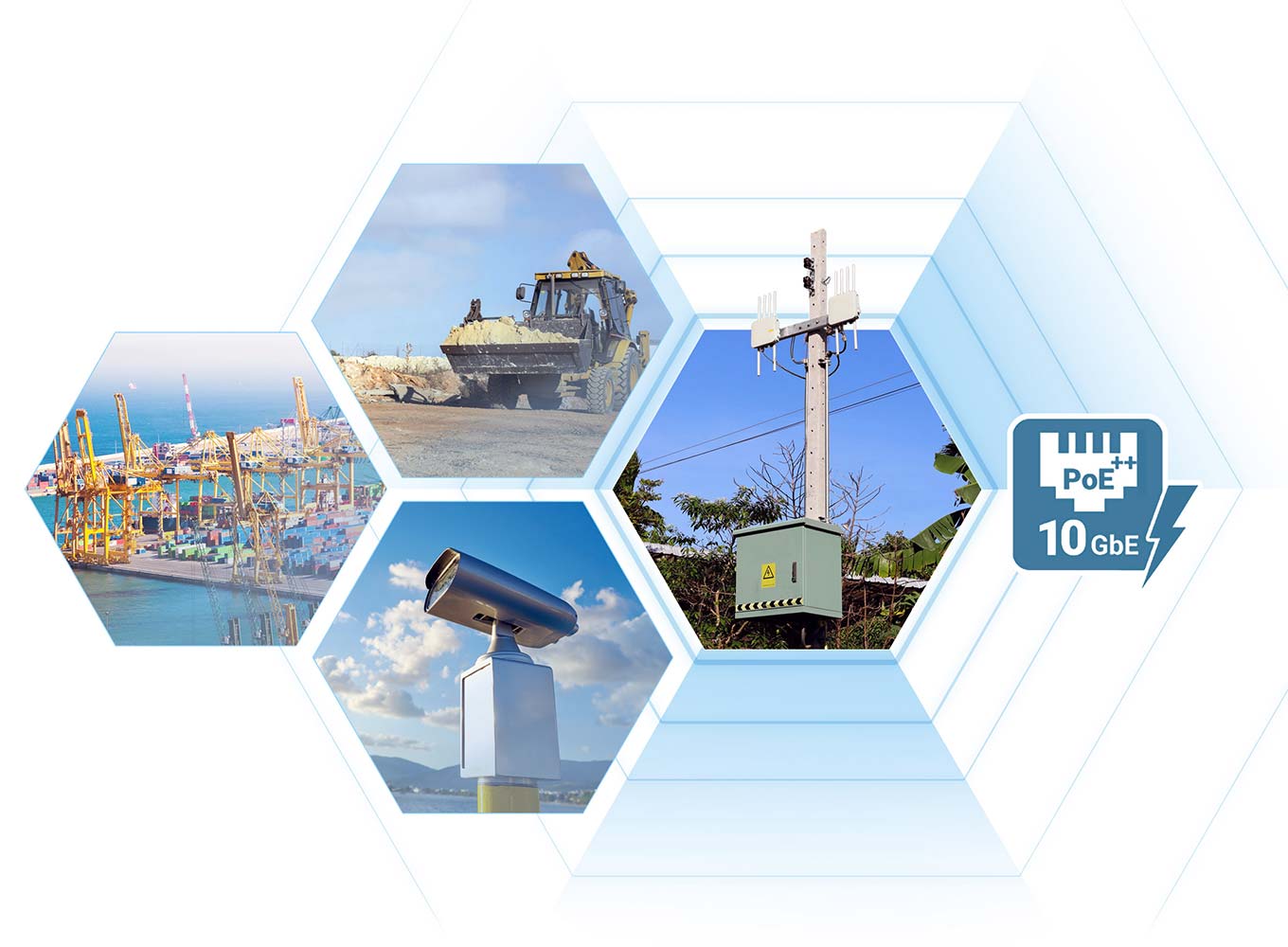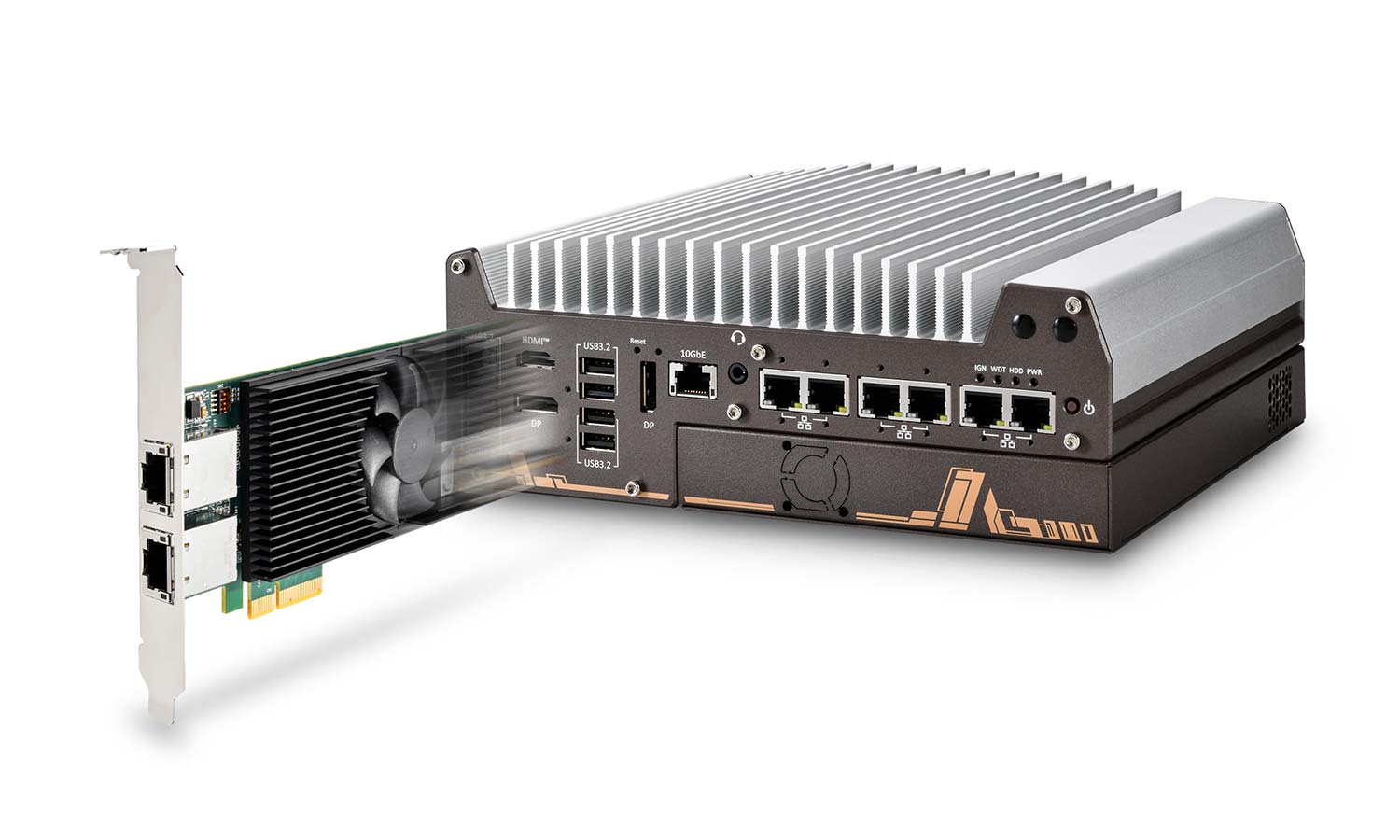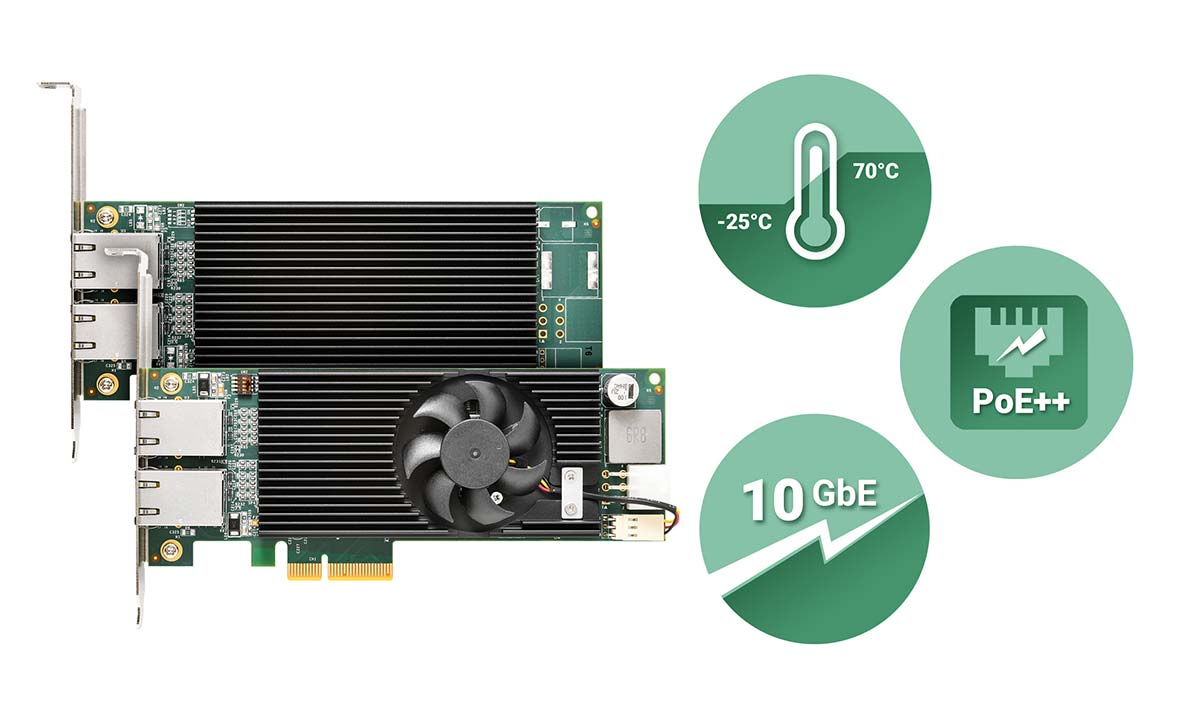Overview

The evolution of industrial Gigabit Ethernet cards combining Power over Ethernet (PoE) functionality has mimicked the growing demand for higher bandwidth, increased power delivery, and rugged reliability in modern industrial applications. Initially, 1Gb Ethernet PoE cards dominated the landscape, offering up to 15.4W per port under IEEE 802.3af (PoE) and later up to 30W per port with IEEE 802.3at (PoE+). These solutions served well for powering peripheral devices at the time, such as Gigabit IP cameras (requiring 3W to 5W), PoE-powered panel PCs, etc.
With the emergence of bandwidth-intensive applications, such as high-resolution video surveillance, AI-powered edge devices, and industrial automation, came the need for faster data rates and higher power delivery. This led to the development of 2.5Gb and 5Gb Ethernet PoE cards compliant with NBASE-T standards, maintaining backward compatibility with Cat5e cabling while improving throughput. These intermediate speeds enabled smoother data handling at the cost of generating excessive heat, but without the need to overhaul infrastructures. As a result, efficient thermal management has emerged as a critical consideration in the design and operation of high-speed Ethernet connectivity.
The integration of 10Gb Ethernet for ultra-fast data transfer and IEEE 802.3bt Type 4 (PoE++) for power delivery, offering up to 90W per port, represents a significant advancement in supporting modern edge AI applications and ultra-high-resolution cameras. This combination meets the bandwidth and power demands of next-generation devices.
Challenges of Deploying 10Gb PoE++ Cards in Embedded Systems, in the Field
When 10Gb PoE++ industrial add-on cards are installed into industrial embedded computers, they unlock powerful new capabilities for a range of high-performance edge applications, particularly in intelligent factory, smart city and public infrastructure deployments. These add-on cards provide both high-speed data transmission and robust power delivery over a single Ethernet cable, streamlining installation and reducing the need for separate power lines in remote or difficult-to-access areas. This makes them ideal for outdoor high-speed WiFi 7/ 6 access points, PTZ cameras, AI-powered PTZ precision cameras, smart light poles, and kiosk information stations. In these scenarios, reliable power and high-throughput data are critical. At the same time, these application deployments pose thermal management challenges during operation due to environmental conditions, and both fast data throughput and power delivery will result in excess heat generation. Therefore, most add-on cards rarely have both 10Gb and PoE++, and will only have one or the other advanced specification to minimize the heat generated, to sustain operations.
For example, AI-enabled PTZ cameras deployed in applications such as traffic monitoring or port security often demand up to 51 watts of power via PoE++ (IEEE 802.3bt) and require a sustained data throughput of at least 1 Gbps to enable real-time video streaming, object recognition, and AI inference at the edge. However, the high-performance demands of these cameras also result in elevated power and thermal loads. In harsh environment conditions, there have been instances of PTZ camera failures caused by overheating, where the PoE card was unable to maintain continuous power delivery or data throughput. Such thermal-induced incidents can lead not only to device shutdowns, but also data loss and packet drops, compromising both system reliability and real-time operations.
In addition to performance, the card's durability is also essential. Installed in embedded systems that are often deployed in exposed environments such as roadside, intersections, harbor ports, or public spaces, they must operate reliably in a wide range of environmental conditions. Therefore, PoE cards used in these embedded computers must be capable of withstanding wide range temperatures, especially for high data throughput and sustained power output operations.
Power-hungry devices such as pan-tilt-zoom (PTZ) cameras, 8K ultra-high-resolution cameras (typically requiring up to 50W), wireless access points, and embedded industrial PCs can all be supported through a single Ethernet cable. PoE++ simplifies installation with streamlined cabling and efficient power management—key advantages for high-density smart city deployments across roadsides, seaports, industrial zones, agriculture fields, and mining operations.
Neousys' Industrial Wide Temperature 10GbE PoE++ Card
Neousys Technology offers a robust range of industrial-grade PCIe add-on cards engineered to meet the stringent demands of harsh and mission-critical environments, including Gigabit, 2.5Gb and 10Gb cards with or without PoE. When released, the 10Gb high-speed Ethernet cards with advanced PoE++ IEEE 802.3bt, were one of the first 10Gb PoE++ cards specifically designed for industrial operations. The card enhanced system performance by enabling up to 10Gb of data throughput and up to 90W per port power delivery, crucial for smart city and intelligent factory applications such as machine vision, public safety monitoring, and industrial automation.
What sets the Neousys' 10Gb PoE++ card apart is its wide-temperature operation capability, withstanding extreme ambient temperatures ranging from -25°C to 70°C. Its strategic component placement design ensures continuous operation in extreme weather, from scorching summer heat to freezing winter temperatures, making it particularly suitable for deployment in outdoor applications such as roadside infrastructure, and remote industrial locations where environmental control is limited.
The 10Gb Ethernet interface can support multiple high-resolution data streams simultaneously or high-power devices such as outdoor WiFi 7 AP, ideal for real-time analytics, public safety monitoring, and large-scale sensor integration across smart city platforms. In addition, the ability to supply up to 90W per port to power devices also simplifies network deployment by reducing infrastructure complexity while lowering total cost of ownership.
Engineered for industrial computers and applications, the card incorporates rugged and highly-reliable components to ensure stable and consistent performance in demanding and thermal volatile environments. Its low-profile, plug-and-play PCIe Gen3 x4 interface enables seamless integration across a wide range of industrial PC systems, simplifying deployment complexity while reducing system downtime. The card supports GigE Vision 3.0 cameras with RDMA (Remote Direct Memory Access) technology, which significantly enhances data transfer efficiency by bypassing traditional CPU-intensive packet handling and memory copy operations. This results in up to 90% reduction in CPU utilization, allowing more resources to be dedicated to real-time processing tasks such as image analysis and AI inference. For industries requiring optimized performance, power distribution, and enhanced reliability in harsh environments, Neousys 10Gb PoE++ card is an ideal future-ready solution capable of sustaining high-throughput and low-latency connections for modern applications.
By integrating Neousys 10Gb PoE++ card into your embedded computer, it enables a compact yet highly capable solution for powering and networking intelligent devices in mission-critical indoor/ outdoor applications. Its combination of high-power output, fast data transmission, and industrial-grade reliability ensures your solution meets the rigorous demands of next-generation smart infrastructure.
- Learn more about Neousys Frame Grabber Cards:
https://www.neousys-tech.com/en/product/feature/industrial-add-on/frame-grabber-card




